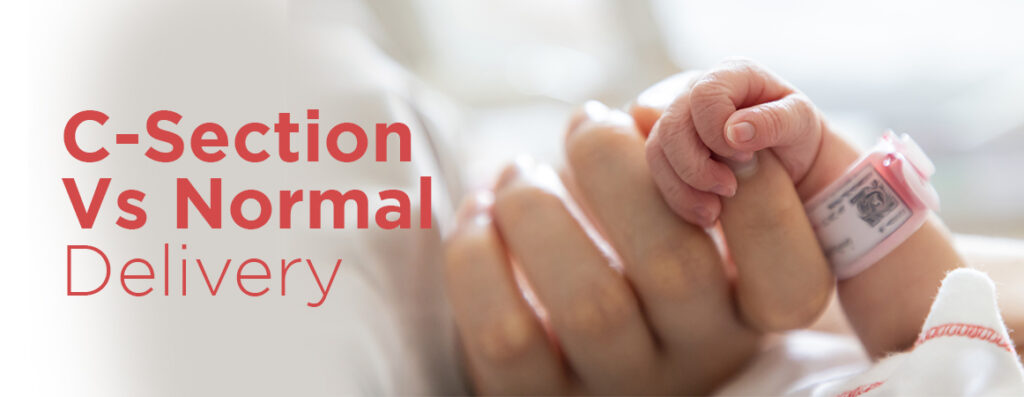C-Section Vs Normal Delivery
What is a C-Section?
To deliver the baby by surgery, a C-section requires making an incision in the mother’s abdomen and uterus. It’s chosen when vaginal delivery poses risks to either the mother or the baby, or in specific medical circumstances necessitating surgical intervention for safe delivery.
Benefits and Risks of C-Section
Benefits:
- Controlled Timing: Allows for planned delivery, which can be advantageous in cases where early delivery is necessary.
- Reduced Risks of Birth Trauma: Helps avoid complications related to prolonged labor or difficult childbirth.
- Management of Maternal Conditions: Provides a safe option for mothers with conditions like placenta previa or active genital herpes.
Risks:
- Surgical Complications: Such as infection, blood loss, and longer recovery time compared to vaginal birth.
- Potential for Future Pregnancy: May increase the risk of placental complications in subsequent pregnancies.
What is Normal Delivery?
The normal delivery technique, also known as vaginal birth, is the way the infant naturally enters the birth canal. It’s the preferred method when both mother and baby are healthy and there are no complications.
Benefits and Risks of Normal Delivery
Benefits:
- Natural Process: Promotes bonding between mother and baby and supports the baby’s respiratory adaptation.
- Shorter Recovery: Generally, this results in a quicker recovery period compared to the C-section.
- Lower Risk of Respiratory Issues: Babies born vaginally are less likely to experience respiratory problems than those delivered via C-section.
Risks:
- Labor Challenges: Potential for prolonged labor, perineal tears, and need for interventions like forceps or vacuum extraction.
- Inflexibility in Timing: Labor may not progress as expected, leading to the need for an emergency C-section.
Indications for C-Section vs Normal Delivery
C-Section Indications:
- Maternal Conditions: Such as placenta previa, preeclampsia, or maternal health concerns.
- Fetal Complications: Such as breech presentation or fetal distress requiring immediate delivery.
- Previous C-Section: An elective repeat C-section may be recommended for mothers with prior C-sections.
Normal Delivery Indications:
- Low-Risk Pregnancy: Where both mother and baby are healthy and there are no anticipated complications.
- Desire for Natural Birth: When the mother prefers to avoid surgery and recover naturally.
Early and Premature Delivery Considerations
Early delivery encompasses childbirth before 39 weeks of gestation, whether via C-section or normal delivery. Premature delivery, occurring before 37 weeks, demands immediate medical attention due to heightened risks for the baby, such as respiratory issues, developmental delays, and feeding difficulties. Managing early and premature deliveries involves careful monitoring by healthcare professionals to ensure optimal outcomes for both mother and child. Early detection of symptoms like contractions or vaginal bleeding is crucial for timely intervention and minimizing potential complications associated with premature birth.
Causes and Symptoms
Causes:
- Medical Conditions: Such as preterm labor, infections, or placental abnormalities.
- Maternal Health Factors: Chronic conditions like hypertension or diabetes.
- Multiple Gestations: Twins or higher-order multiples may necessitate early delivery.
Symptoms:
- Contractions: Premature labor may be indicated by regular contractions before the 37th week.
- Vaginal Bleeding: A sign of potential complications requiring medical evaluation.
- Decreased Fetal Movement: Reduced movements can indicate fetal distress, prompting the need for early delivery.
Conclusion
Choosing between C-section and normal delivery involves understanding the benefits, risks, and medical indications associated with each method. While C-sections provide a controlled delivery option and may be necessary in certain medical conditions, normal deliveries support natural childbirth experiences and quicker recovery times for many women. It’s essential for expectant mothers to discuss their preferences and medical considerations with healthcare providers to make informed decisions about childbirth. Ultimately, the goal is to ensure the safest and healthiest outcome for both mother and baby, guided by medical advice and individual circumstances.
Post Disclaimer
The information contained in this post is for general information purposes only. The information is provided by "C-Section Vs Normal Delivery "and while we endeavour to keep the information up to date.
Legal Disclaimer
We do not claim to cure any disease which is considered’ incurable ‘ on the basis of scientific facts by modern medicine .The website’s content is not a substitute for direct, personal, professional medical care and diagnosis. None of the medicines mentioned in the posts ,including services mentioned at "medicineguide.us" should be used without clearance from your physician or health care provider.
Testimonials Disclaimer– : Results may vary, and testimonials are not claimed to represent typical results. The testimonials are real, and these patients have been treated with homeopathy treatment from our clinic . However, these results are meant as a showcase of what the best, Medicine can do with their disease contions and should not be taken as average or typical results.


